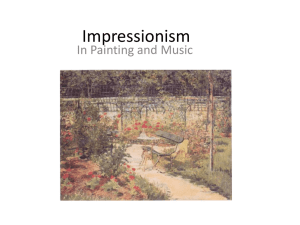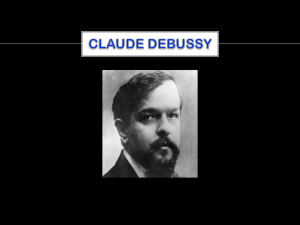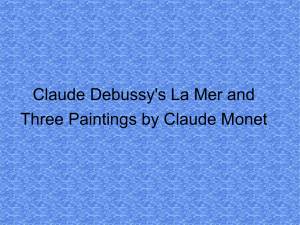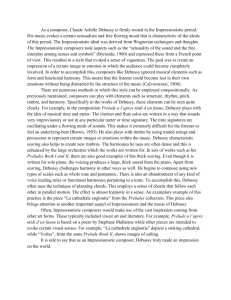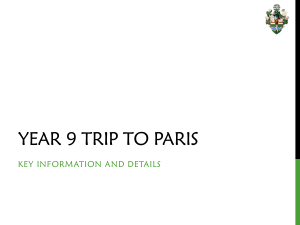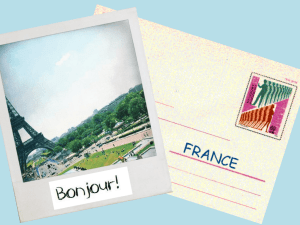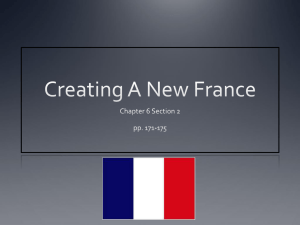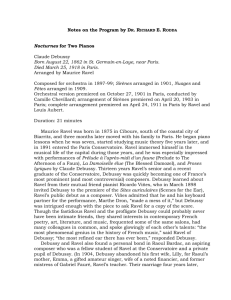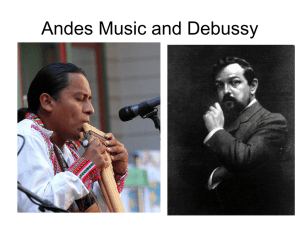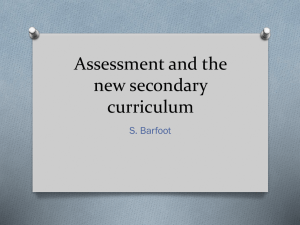Chapter 49. The Early Music of Beethoven
advertisement
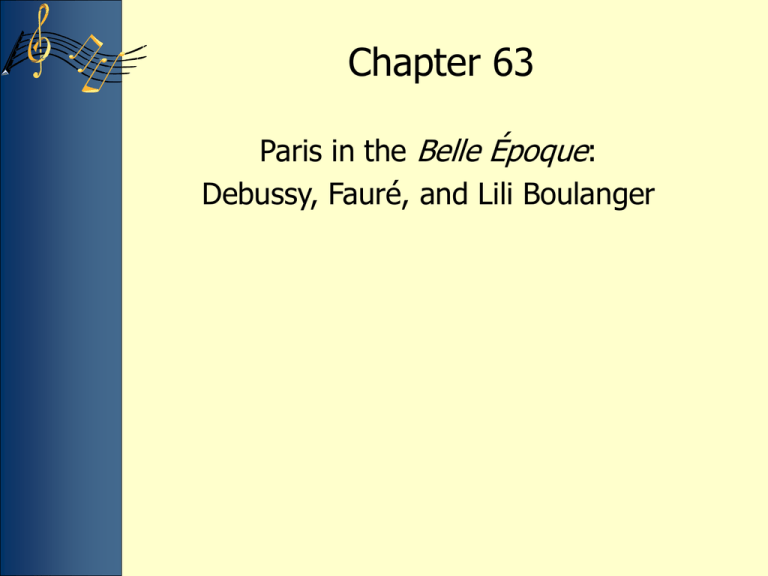
Chapter 63 Paris in the Belle Époque: Debussy, Fauré, and Lili Boulanger Lecture Overview • Paris at the turn of the 20th century • Impressionism and symbolism in French painting and literature • Claude Debussy – – – – life and music “En sourdine” “Reflets dans l’eau” “Nuages” • Gabriel Fauré – life and music – “Dans la forêt de septembre” • Lili Boulanger – life and music – “Elle est gravement gaie” • Review The Life of Claude Debussy (1862–1918) • • • • • • 1862 1872 1885 1887 1902 1918 born near Paris enters the Paris Conservatory wins the Prix de Rome returns to Paris premiere of opera Pelléas et Mélisande dies in Paris Principal Compositions by Claude Debussy • Piano: character pieces including Preludes and Etudes • Songs: some 60 • Chamber music: including – – – – String Quartet Sonata for cello and piano Sonata for flute, viola, and harp Sonata for violin and piano • Orchestra: tone poems and character pieces including – Prelude to The Afternoon of a Faun – Nuages – The Sea (La mer) • Opera and ballet: – Pelléas et Mélisande (opera) – Jeux (ballet) Impressionism in Painting and Music When we compare a painting such as Claude Monet’s Wild Poppies (above, 1873) to a work by Claude Debussy such as Reflets dans l’eau, we find the similarities that have led audiences from Debussy’s time to our own to refer to both as “Impressionists.” Both favored subjects drawn from nature at its most beautiful, and both use pure colors to bring their scenery alive. A strictness of organization beneath the surfaces of these works supports an apparent freedom above. Most of all, both painter and musician are refined, subtle, and supremely evocative. Claude Debussy, “En sourdine,” 1891, from Fêtes galantes I Through-composed or free ternary form Claude Debussy, “Reflets dans l’eau” from Images I for piano, 1905 Free form (with elements of sonata form) 72 Claude Debussy, “Nuages,” from Three Nocturnes for orchestra, 1900 Ternary form The Life of Gabriel Fauré (1845–1924) • 1845 born in a village in south-central France • 1854 studies church music in Paris • 1866 begins the career of church organist and choir director • 1874 appointed choirmaster at Church of the Madeleine in Paris (later becomes its organist) • 1905 appointed professor at the Paris Conservatory, later its Director • 1924 dies in Paris Principal Compositions of Gabriel Fauré • Songs: over 100 • Dramatic music: operas and incidental music to plays (including Maeterlinck’s Pelléas et Mélisande) • Chorus: motets and a Requiem (1877, later revised) • Chamber music: sonatas for violin and for cello, music with piano • Piano: nocturnes, impromptus, barcarolles; Dolly for piano four hands Gabriel Fauré, “Dans la forêt de septembre,” 1902 Rondo form The Life of Lili Boulanger (1893–1918) • 1893 born in Paris to family of leading musicians • 1898 enrolls at the Paris Conservatory, studies with Gabriel Fauré • 1913 wins the Prix de Rome, the first female composer to be so honored • 1918 dies in Paris of Crohn’s disease, age of 24 Principal Compositions by Lili Boulanger • Chorus: several pieces for the church; cantata Faust et Helène • Piano: preludes, variations, character pieces • Songs: include the cycle Clairières dans le ciel Lili Boulanger, “Elle est gravement gaie” Clairières dans le ciel, 1914 Ternary form from Review Key Terms • • • • • • • • Belle époque Paul Verlaine fête galante impressionism Claude Monet whole-tone scale octatonic scale pentatonic scale
